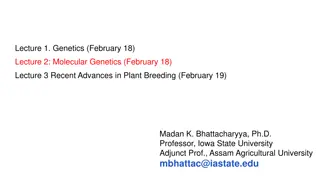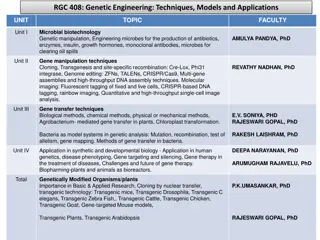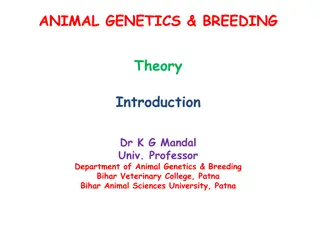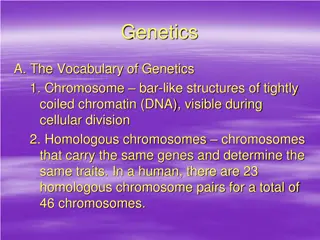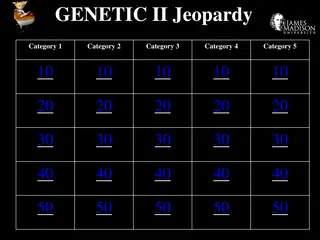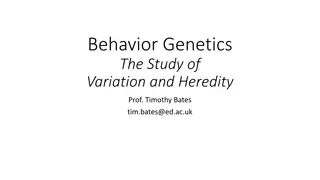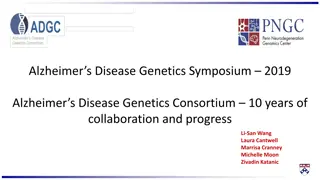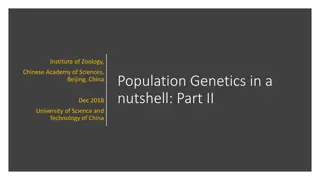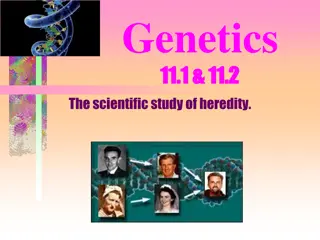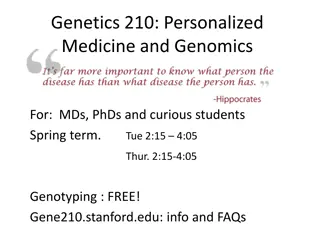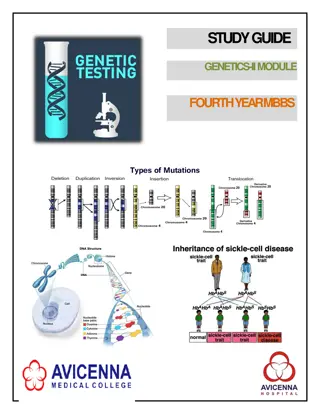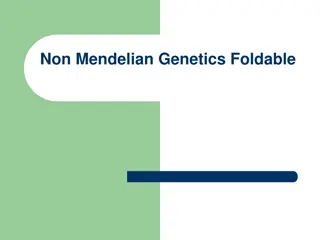Polymorphisms in Genetics
Polymorphisms in genetics refer to variations in the DNA sequence among individuals. These variations can be monomorphic or polymorphic, with different types such as protein/enzyme polymorphisms, DNA polymorphisms, RFLPs, SNPs, VNTRs, and STRs. Understanding these variations can provide insights into genetic diversity and marker identification.
Download Presentation

Please find below an Image/Link to download the presentation.
The content on the website is provided AS IS for your information and personal use only. It may not be sold, licensed, or shared on other websites without obtaining consent from the author.If you encounter any issues during the download, it is possible that the publisher has removed the file from their server.
You are allowed to download the files provided on this website for personal or commercial use, subject to the condition that they are used lawfully. All files are the property of their respective owners.
The content on the website is provided AS IS for your information and personal use only. It may not be sold, licensed, or shared on other websites without obtaining consent from the author.
E N D
Presentation Transcript
Chapter-4 POLYMORPHISMS
Introduction Suppose that we gathered DNA from a large number of individuals and examined the first 1,000 nucleotides on the first chromosome. There would be some sections in which the base pair sequence is the same for all of the DNAstrands. These are called monomorphic sections. There will be other sections in which the sequence of nucleotides differs. These are called or, simply, polymorphisms. Using the analogy of a four-letter DNA alphabet, polymorphisms are really spelling variations. The term allele refers to a specific spelling variation. sections polymorphic
Continued Polymorphism A DNA polymorphism is a sequence difference compared to a reference standard that is present in at least 1 2% of a population. Polymorphisms can be single bases or thousands of bases. Polymorphisms may or may not have phenotypic effects.
Types of polymorphisms Generally, they are two categories. I. Protein/enzyme polymorphisms II. DNA polymorphisms A. Restriction fragment length polymorphisms (RFLP) B. Single nucleotide polymorphisms (SNPs) C. Tandem repeat polymorphisms(VNTRs & STRs) D. Structural polymorphisms (deletions, inversions, etc.) E. Sequence polymorphisms
Protein/enzyme polymorphisms In the early days of human genetics, the majority of polymorphisms were those associated with proteins and enzymes. To detect the polymorphism and a person s genotype, one performed assays for the gene product, i.e., the protein or enzyme produced by the genetic blueprint. Most of these polymorphisms were detected in blood. When your blood is typed, you are informed that you are blood group O+ orAB- orA+, etc.
Protein/enzyme polymorphisms The letter in this blood group gives your phenotype at the ABO locus, and the plus (+) or minus (-) sign denotes your phenotype at the Rhesus gene. These polymorphisms are still used today to assess suitability of donors and recipients for blood transfusions (ABO locus) and to assess Rhesus incompatibility between a mother and her fetus. However, blood group polymorphisms have given way to other, more sophisticated techniques in modern human genetic research.
DNA Polymorphisms The other large class of polymorphisms are those that detect spelling variations at the level of DNA nucleotides. DNA differs person to person! All individuals genetically unique (except identical twins). Polymorphisms are found throughout the genome. If the location of a polymorphic sequence is known, it can serve as a landmark or marker for locating other genes or genetics regions. Each polymorphic marker has different versions or alleles. For our purposes, we can classify them into the following types, each of which is discussed below.
Restriction Fragment Length Polymorphisms (RFLP) They are inherited genotypes For each locus, one allele is inherited from each parent. Restriction fragment sizes are altered by changes in or between enzyme recognition sites. Detect alleles by Southern Blot Hybridization
Single nucleotide polymorphisms A single nucleotide polymorphism or SNP is a sequence of DNA on which humans vary by one and only one nucleotide. Because humans differ by one nucleotide per every thousand or so nucleotides, there are millions of SNPs scattered throughout the human genome. The major advantage of SNPs, however, lies in the fact that they can be detected in a highly automated way using specialized DNA chips usually called DNA arrays.
SNPs Single-nucleotide differences between DNA sequences. One SNP occurs approximately every 1,250 base pairs in human DNA. SNPs are detected by sequencing, melt curve analysis, or other methods. 99% have no biological effect; 60,000 are within genes.
SNPs Point mutations (base substitutions) found in 1% or more of the population 1.8 million identified in human genome Detected on micro-array plates with fluorescent tags (all or nothing response) ~50 SNPs provides same power of discrimination as 13 STR loci Certain SNPs used as predictors of ancestry/ethnicity by a private sector lab (DNAWitness)
Tandem repeat polymorphisms A tandem repeat polymorphism consists of a series of nucleotides that are repeated in tandem (i.e., one time after another). The polymorphism consists of the number of repeats. Unfortunately, even though the concept of the tandem repeat is quite simple, the terminology for referring to these polymorphisms is very confusing. All of the following terms may be used for a tandem repeat: simple sequence repeat (SSR), short tandem repeat (STR), variable number of tandem repeats (VNTR), microsatellite, and minisatellite.
Short Tandem Repeat Polymorphisms (STR) STR are repeats of nucleotide sequences. AAAAAA - mononucleotide ATATAT - dinucleotide TAGTAGTAG - trinucleotide TAGTTAGTTAGT - tetranucleotide TAGGCTAGGCTAGGC - penta nucleotide Different alleles contain different numbers of repeats. TTCTTCTTCTTC - four repeat allele TTCTTCTTCTTCTTC - five repeat allele
Structural variants Here, we use the term structural variants to refer to spelling variations that involve deletions or insertions of a nucleotide sequence, inversions, and translocations. When the structural variant is somewhat large (some geneticists define large as 1 kilobase or more, others 10 kb), the polymorphism is called a copy number variant or CNV. There is considerable research being done on CNVs and medical disorders, including psychopathology. Insertion-deletion polymorphisms or indels, are intuitive examples.
Continued Whether an allele is called an insertion or deletion, however, depends on the consensus nucleotide sequence of the human genome. If an allele is missing a nucleotide sequence that is present in the consensus sequence, then the allele is a called a deletion. If the allele contains a nucleotide sequence that is not in the consensus sequence, then it is an insertion. A particularly important type of insertion occurs when a section of DNA is duplicated and inserted into the same region. Such a phenomenon creates pseudegenes.
Continued These are sections of DNA with a nucleotide sequence very similar to a known gene but the DNAdoes not produce a functional polypeptide. Most pseudogenes resulted from duplications. An inversion polymorphism occurs when one allele has a nucleotide sequence that is reversed in another allele. The inverted allele has a section that has the same spelling but is read in reverse from right to left instead of the ordinary left to right order. Inversions usually occur when a chromosome breaks in two places and DNA repair mechanisms mistakenly splice the middle fragment back but in reverse order. Typically they involve many thousands of base pairs. A translocation occurs when a section of DNA is deleted from one chromosome and then inserted into another chromosome.
Sequence polymorphisms The ultimate polymorphism is to actually have the whole sequence of nucleotides for a region for a large number of DNA strands and then examine all of the differences among the strands. Here, the DNA differences could be a SNP, a tandem repeat or a structural change. There is no accepted term for this phenomenon, so we call them sequence polymorphisms.



